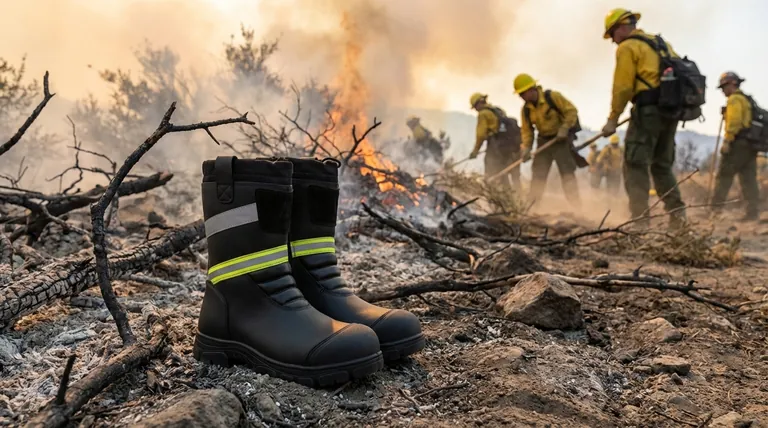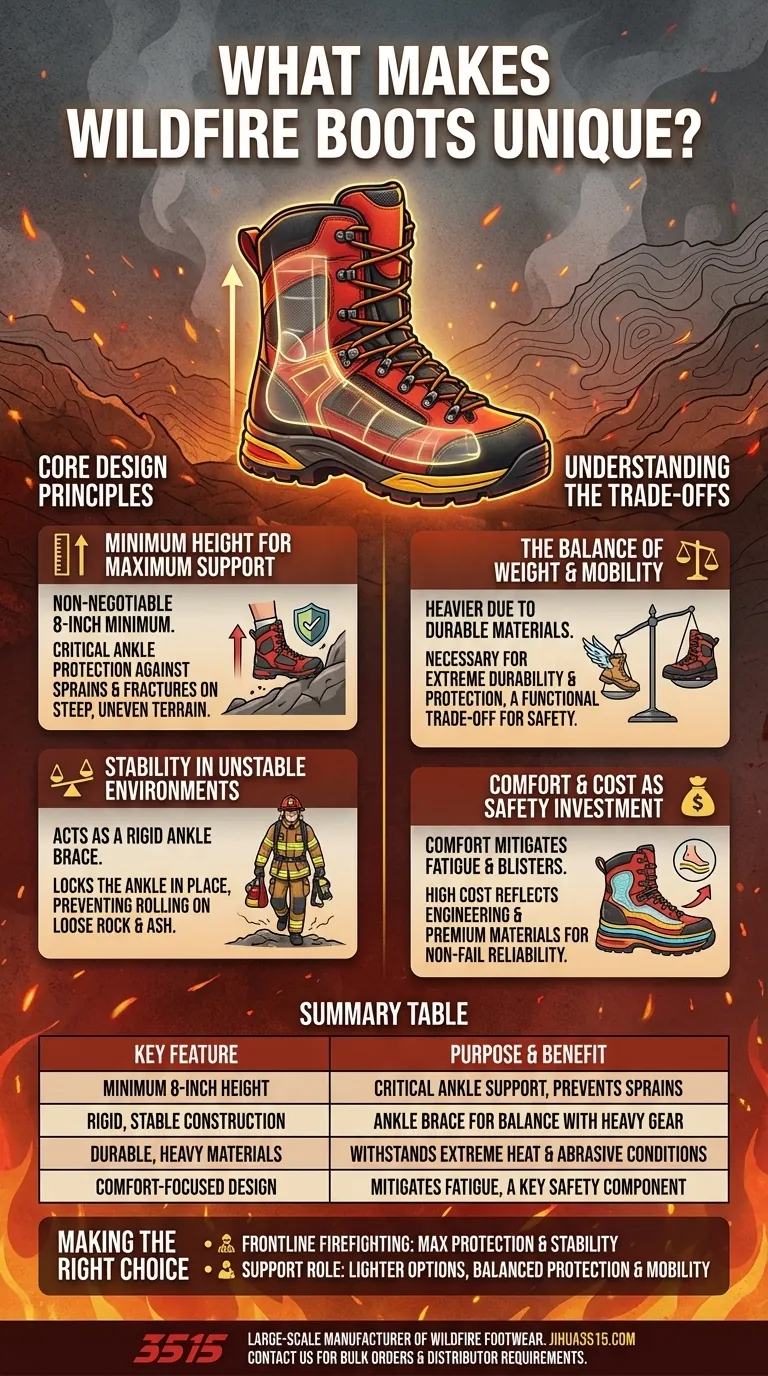At first glance, a wildfire boot might seem like any other heavy-duty work boot. However, its uniqueness lies in its specific design as a piece of life-saving equipment for one of the world's most demanding jobs. These boots are defined by a non-negotiable set of features engineered to protect against the extreme and unpredictable hazards of a wildland fire, starting with their mandatory height.
Wildfire boots are not merely rugged footwear; they are a specialized safety system. Every design choice, especially their mandatory minimum 8-inch height, is a deliberate trade-off that prioritizes ankle integrity and stability over the conventions of a standard work boot.

The Foundation of Protection: Core Design Principles
The features that make a wildfire boot unique are not for aesthetics; they are functional requirements born from the harsh realities of the fireline. Each element serves a specific protective purpose.
Minimum Height for Maximum Support
The most immediate differentiator is a minimum height of 8 inches from the heel bottom to the top of the boot.
This specification is non-negotiable. It provides critical protection against the most common injuries in the field: severe ankle sprains and fractures caused by navigating steep, uneven, and often unstable terrain.
Stability in Unstable Environments
The tall, rigid structure of the boot acts as a brace. It locks the ankle in place, preventing it from rolling when a firefighter steps on loose rock, slick ash, or into a hidden hole.
This added stability is essential for maintaining balance while carrying heavy gear and working for long, grueling hours on treacherous ground.
Understanding the Trade-offs
While these protective features are critical, they come with inherent trade-offs. Understanding these compromises is key to appreciating the boot's specialized nature and making an informed choice.
The Balance of Weight and Mobility
Wildfire boots are heavy. This weight is a direct consequence of the durable materials and robust construction necessary to withstand extreme conditions.
While some may seek lighter materials for increased mobility, this often comes at the cost of durability or protective capability. The weight is a functional trade-off for safety.
Comfort as a Safety Feature
Given the long hours on foot, comfort is not a luxury—it's a critical safety component. An uncomfortable boot can cause blisters, fatigue, and distraction, all of which are dangerous on the fireline.
Features like breathable linings and proper arch support are crucial for mitigating these risks, allowing firefighters to stay focused and effective.
Cost as a Long-Term Investment
The high cost of a quality wildfire boot can be a significant concern. However, this price reflects the engineering, testing, and premium materials required to ensure the boot will not fail under extreme stress.
Viewing this cost as an investment in personal safety and professional productivity is essential. A boot failure in the field is not an inconvenience; it is a catastrophic safety incident.
Making the Right Choice for Your Goal
Selecting the right boot depends on balancing these factors against your specific role and priorities.
- If your primary focus is frontline firefighting: Prioritize maximum protection and stability, accepting the inherent trade-offs of greater weight and higher cost.
- If your primary focus is a support role requiring high mobility: You may consider lighter-weight options that still meet all safety standards, carefully balancing protection with the need to move quickly.
Ultimately, choosing the right wildfire boot is a critical decision that directly impacts your safety and effectiveness in the field.
Summary Table:
| Key Feature | Purpose & Benefit |
|---|---|
| Minimum 8-Inch Height | Provides critical ankle support and prevents sprains on unstable terrain. |
| Rigid, Stable Construction | Acts as an ankle brace for balance while carrying heavy gear. |
| Durable, Heavy Materials | Withstands extreme heat and abrasive conditions for long-term reliability. |
| Comfort-Focused Design | Mitigates fatigue and blisters during long shifts, a key safety component. |
Need reliable, high-performance wildfire boots for your team?
As a large-scale manufacturer, 3515 produces a comprehensive range of safety footwear for distributors, brand owners, and bulk clients. We understand the non-negotiable safety standards required for wildfire fighting. Our production capabilities ensure durable, compliant boots that protect your personnel and enhance their effectiveness in the field.
Contact us today to discuss your specific requirements and receive a quote. Let us equip your team with the gear they can depend on.
Visual Guide

Related Products
- High Performance Fire-Retardant Waterproof Safety Boots
- Wholesale Waterproof Tactical Boots Custom Suede & High-Traction Soles
- Durable Leather Tactical Boots Wholesale & Custom Manufacturing for Brands
- Premium Wholesale Waterproof Safety Boots High Performance Protection for Industrial Markets
- Premium Grain Leather Safety Boots for Bulk Supply
People Also Ask
- How should one choose between steel toe and composite toe shoes? Match Your Work Hazards for Optimal Safety
- How does the weight of steel-toe boots compare to composite-toe boots? Uncover the Real Trade-Offs
- When are steel-toe boots required or recommended? Essential Guide to Workplace Foot Safety
- What are the main types of safety-toe boots? Choose the Right Protection for Your Job
- Which industries commonly use steel toe boots? Essential Foot Protection for High-Risk Jobs



















